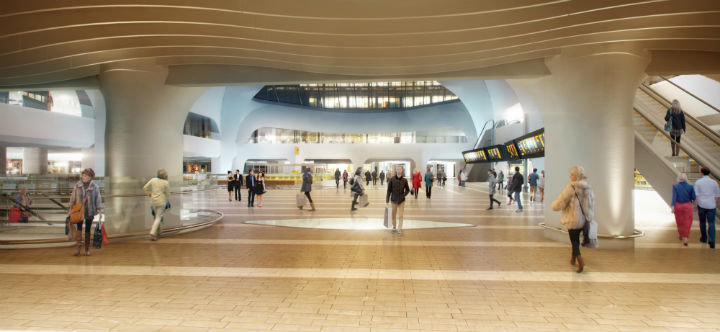Railway stations are special places; places of entry and exit, meeting places and places of farewells. They have acted as an important setting for many famous movies, novels and paintings. Great cities are often associated with well-designed, iconic railway stations.
Birmingham used to have an iconic railway station. The first New Street station opened in 1854 and had the largest iron and glass roof in the world – an impressive entry to the city of a thousand trades or the workshop of the world. This station was damaged by bombing raids during the Second World War and was eventually demolished in 1964 and replaced in 1967.

This new station was innovative, but not for its architecture. For the first time, British Rail sold the ‘air rights’ above a station. This sale led to the construction of the Pallasades Shopping Centre in 1970. The sale of the air rights and the design of the Pallasades transformed New Street Station into a gloomy and claustrophobic space.
The 1960s New Street station and the Pallasades provided Birmingham with a semi-functional railway station and a bland shopping centre. The new station was not a special space, a space of memories and experiences.
In September 2015, Network Rail completed a major redevelopment of New Street station that included the transformation of the Pallasades into Grand Central shopping centre.
There are many different interpretations of this redevelopment. First, the redevelopment of New Street station has been needed for perhaps more than two decades. The key question is why this redevelopment took so long to get off the ground. The answer lies in the difficulty of aligning decision-makers based in London with the needs of Birmingham. The project required support from Network Rail, Birmingham City Council, the Department for Business, Innovation and Skills, Centro, and the Department of Transport. For too long New Street Station has held back economic growth in the city, and the redevelopment should have been completed in the last century.
Second, Grand Central brings John Lewis to Birmingham, along with other major national and international retailers and some local retailers. This is good news for the city, but what about the economy? The economic value of Grand Central needs to be based on a comparative analysis of the jobs lost with the closure of the Pallasades and the new jobs created at Grand Central. In economic terms, the employment impact of Grand Central is not that significant. A retail job is a job, but it is often low paid with limited economic multipliers into the wider economy. The redevelopment of the station created many construction jobs, and at the same time project management enabled the station to function. Nevertheless, there will have been short-term negative impacts from the disturbance related to the redevelopment that are difficult to measure.
Third, there is no question that the redevelopment of New Street has transformed the station into an iconic building. The new station provides additional capacity with a much-expanded concourse and more direct links for pedestrians from the station to the city. However, the redevelopment has had to work within the constraints imposed by the 7.5-acre concrete raft that was placed over New Street station in the 1960s. This means that the station platforms are still gloomy and claustrophobic, but the concourse and the shopping centre have been transformed. The platform gloom comes from the sale of the air rights and the constraints of 1960s architecture.
Fourth, Birmingham is experiencing a moment of transformation. This takes two forms. On the one hand, there is the ongoing development of a Combined Authority, or a new governance structure for the conurbation. On the other hand, major capital investments are under way or planned, combined with some major new entrants to the local economy (the relocation of the headquarters of HSBC [UK] to Birmingham).
The new Birmingham needed an iconic railway station; a station that reflects the ambitions of the Combined Authority, but also the strength of the local economy. Over the next decade, Birmingham New Street and Grand Central will act as a nodal point for the physical regeneration of the areas around the station. The opening of the new station is only the beginning of this investment’s impact on Birmingham, and it will be interesting to assess the wider impacts as they emerge over the next decade.
Professor John R Bryson, Director of the City-Region Economic Development Institute (City-REDI), Birmingham Business School, University of Birmingham